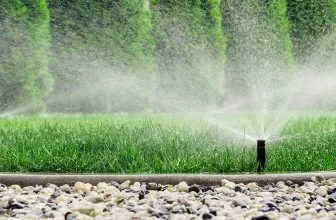Spreading a good layer of mulch can do wonders for your planting beds and a lot of other landscaping features. Though knowing just how much mulch to use can get complicated.
Different types of beds and features need different sizes of mulch. Especially if they are being used as a weed blocker, or to help a young tree retain moisture put to the drip edge.
The thickness of mulch can also be a factor. If it’s too thick it can compact the soil underneath and potentially block water from easily making it down to the plant’s roots. In some conditions, it can even lead to mold contamination and other soil-borne diseases.
If your mulch layers are too thin, weeds can easily push up through the mulch. It can fail to hold in enough moisture causing the soil in your planting beds to dry out.
So, it seems clear that to understand how much mulch you need, we are going to have to take a close look at what mulch is and what it does. Not to mention getting familiar with some of the most common types of mulch used in gardens and landscaping beds.
What Is Mulch & What Does It Do?
Mulch can be made from a wide range of materials including organic things like ground-up tree bark, leaves, or even compost. There are also inorganic forms of mulch like gravel, pebbles, ground rubber, and other synthetic materials.
Mulch is intended to cover soil, though it serves more purposes than just to keep your landscaping beds looking neat and tidy. It also helps to prevent weeds from establishing a presence or competing with existing plants in the bed. At the same time, it also helps the soil retain moisture, which keeps desirable plants and trees from drying out.
Organic mulch takes things a step further by also adding nutrients and organic matter to the bed over time. Though it also means you will likely need to apply it or update it year after year.
The Benefits of Organic Mulch
There are many different types of organic mulch. Some take months to years to decompose into the underlying soil, while others decompose within a matter of weeks. This can influence just how much mulch you need to apply to a planting bed.
Some of the most common types of organic mulch include:
round Tree Bark & Wood Chips
Created by griding up fallen trees ground bark and wood chips are relatively easy to find. Unprocessed wood chips tend to decompose over the course of a year or two and are gray to dark brown in color. The type of tree it came from is also a factor, with some wood like cedar lasting longer than other softwoods like birch or alder.
You can spread wood chip mulch two to four inches thick to create an effective weed block and help retain soil moisture. Though you might need to touch up the planting bed the next year.
Processed or treated wood chips are available in a wide variety of colors. They tend to cost a little more, but they can last two or more years. You can spread these treated wood chips two to four inches thick and touch them up every two to three years.
Hay & Straw
Hay & straw are used as mulch in garden beds and in agricultural applications. Though they have some drawbacks and must be chosen and used with care. Too much can promote fungal diseases and mold. Yet it also helps to introduce organic material to the soil over time. You should spread hay or straw mulch in layers that are three to four inches thick.
Dried, Ground Leaf Mulch
Most hardwood trees shed their leaves in the fall, they can then be coarsely ground and used as a fall mulch to help protect sensitive perennials and berry plants. They tend to decompose slowly but can be prone to mold problems with applied too thickly. Most people who use leaf mulch do so over the fall and winter in three to four-inch-thick layers, then rake it away and add it to their compost pile where it contributes carbon to the composting process.
Sawdust From Unprocessed Wood
If you are going to use sawdust for a mulching material, you need to make sure it is only sourced from unprocessed wood. Most lumber and treated lumber have trace chemicals that will leach into your soil. If you use unprocessed sawdust, it’s best to use it in combination with another type of organic mulching material. Otherwise, a layer thicker than 1 to 2 inches on it’s own will mat down to create a semi-impermeable water barrier.
Compost
You need to use a light hand when applying compost as mulch, and you should only use a material that has completed the composting process. So-called “Hot Compost” can burn out plants, especially young seedlings, and annual flowers.
Because it is so nutrient-dense, and has the potential to over-fertilize or burn out tender plants, you should only spread compost mulch 1 to 1.5-inches thick.
Grass Clippings
Grass clippings from a bagging lawnmower can be used sparingly in vegetable and herb gardens to side-dress plants and block out weeds. It is high in nitrogen and will affect the soil chemistry if applied too thickly. This grass-clipping mulch can also be prone to mold and other fungal diseases. So, you should only spread grass clippings in a layer 1 to 2 inches thick.
Popular Types of Synthetic Mulch
Synthetic mulch has continued to grow in popularity thanks to its consistent visual appearance and long-lasting power. A lot of synthetic mulches are available in a wide range of colors, which makes it easy to match them to your existing landscaping concepts. This includes:
Ground Rubber Mulch
Made from old rubber tires, ground rubber mulch helps free space in the landfills, in that it takes about 80 tires to make enough rubber mulch to fill one cubic yard of space. However, it comes with the risk of trace chemicals that are not healthy for garden plants, and should only be used in inorganic applications. It can be spread two to three inches thick.
Landscape Glass Mulch Landscape
Glass mulch is another popular upcycled synthetic mulch material that provides a brighter look to a garden. The reflecting light off the pieces of recycled glass can give your landscaping an ultra-modern look. Recycled glass is typically rolled and buffed to eliminate sharp edges and is considered to be environmentally friendly without any chemicals concern. Though it’s a bit more expensive than other forms of mulch. It will also show all of the leaves and petals that have fallen off the plants, as compared with them falling into a natural mulch, which requires a little more routine upkeep. You can spread recycled glass mulch in layers 2 to 3 inches thick.
Gravel, Pebbles & Stone Chippings
These stone-based mulches provide a neat and professional finish. They also help to insulate the soil which is beneficial for plants that have temperature-sensitive roots A thick layer of gravel is also great for reducing weeds, as weed seeds will be unable to root among gravel or stone chippings as they would be able to in some organic mulches. You can spread gravel and other stone mulches 4 to 6 inches thick to seal out weeds, while still being able to allow water to pass through.
How To Calculate The Volume Of Mulch I Need
Mulch is typically sold by the cubic yard, and a single cubic yard of the material will cover a 324-square-foot area at a depth of 1-inch. You can then your total, multiply your square footage by the depth in inches desired, then divide by 324.
The formula is Square footage x desired depth / 324 = cubic yards needed.






